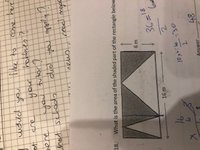You are using an out of date browser. It may not display this or other websites correctly.
You should upgrade or use an alternative browser.
You should upgrade or use an alternative browser.
area of a shaded part of the rectangle
- Thread starter sufinaz
- Start date
pka
Elite Member
- Joined
- Jan 29, 2005
- Messages
- 11,974
But the image in small and sideways making it unreadable.I did attach the pic you can see from there, can't draw here
Dr.Peterson
Elite Member
- Joined
- Nov 12, 2017
- Messages
- 16,604

You have to be a little creative here. They seem to give you too little information, but what they leave out doesn't affect the answer.
One approach to take is to see what fraction of the rectangle is shaded.
Another is to define the base of each triangle by a variable, and determine the shaded area in terms of those variables, hoping that they will cancel out (as they will).
firemath
Full Member
- Joined
- Oct 29, 2019
- Messages
- 602
Think about it. If you took half of the large white triangle and one of the large grey triangles, their area would be the same.can you actually do that? they are two separate triangles in a rectangle
Dr.Peterson
Elite Member
- Joined
- Nov 12, 2017
- Messages
- 16,604
You can't really assume a particular length; but this can count as experimentation to see whether the answer depends on the individual lengths.
Try making the lengths x and y, and see what you get.
Then try drawing in vertical lines through the apex of each white triangle, and observe that you have divided the region into four rectangles, each of which is half white and half black.
Try making the lengths x and y, and see what you get.
Then try drawing in vertical lines through the apex of each white triangle, and observe that you have divided the region into four rectangles, each of which is half white and half black.
ok, when you draw two vertical lines from the triangles apex, you'll have two equal square, their area is 36 each.
the remaining base is 4m ,
area of remaining rectanglesarea is 4x6=24
all have half shaded that means 36+36+24=96/2=48 still 48 m square is that right?
the remaining base is 4m ,
area of remaining rectanglesarea is 4x6=24
all have half shaded that means 36+36+24=96/2=48 still 48 m square is that right?
Dr.Peterson
Elite Member
- Joined
- Nov 12, 2017
- Messages
- 16,604
48 is the correct answer; I've been trying to help you see alternative ways to see the answer, not to correct the answer itself.
Here is the picture I described:

There are four rectangles; each is divided exactly in half by a diagonal. So the shaded triangles are exactly half of the entire figure; their area is therefore exactly half of 6*16, and 6*16/2 = 48m2. We don't need to know how wide each individual rectangle is. No guessing is needed.
Here is the picture I described:

There are four rectangles; each is divided exactly in half by a diagonal. So the shaded triangles are exactly half of the entire figure; their area is therefore exactly half of 6*16, and 6*16/2 = 48m2. We don't need to know how wide each individual rectangle is. No guessing is needed.
D
Deleted member 4993
Guest
Your answer is correct but your logic escapes me!ok, when you draw two vertical lines from the triangles apex, you'll have two equal square, their area is 36 each.
the remaining base is 4m ,
area of remaining rectanglesarea is 4x6=24
all have half shaded that means 36+36+24=96/2=48 still 48 m square is that right?
Post #12 gave the hint for correct solution. If you draw vertical lines from the apexes of every "inside" triangles (three of those - two white and one black), you'll divide the rectangle into 8 right-angled triangles. If observe carefully, you will be able to see congruent white and black triangles.
Thus the sum of the areas of the black triangles is equal to the sum of the areas of the black triangles (shaded area).
Hence shaded area = 96/2 = 48 m2
Steven G
Elite Member
- Joined
- Dec 30, 2014
- Messages
- 14,559
Suppose the base of the left triangle is \(\displaystyle b_1\) Then the area of the left triangle is \(\displaystyle \dfrac{1}{2}b_1\cdot6\)
Suppose the base of the right triangle is \(\displaystyle b_2\) Then the area of the right triangle is \(\displaystyle \dfrac{1}{2}b_2\cdot6\)
Note that \(\displaystyle b_1 + b_2 = 16\)
Now the total area of the triangles is \(\displaystyle \dfrac{1}{2}b_1\cdot6\) + \(\displaystyle \dfrac{1}{2}b_2\cdot6\) = \(\displaystyle \dfrac{1}{2}(b_1 + b_2)\cdot6\) =\(\displaystyle \dfrac{1}{2}\cdot 16\cdot6 = 48\)
Suppose the base of the right triangle is \(\displaystyle b_2\) Then the area of the right triangle is \(\displaystyle \dfrac{1}{2}b_2\cdot6\)
Note that \(\displaystyle b_1 + b_2 = 16\)
Now the total area of the triangles is \(\displaystyle \dfrac{1}{2}b_1\cdot6\) + \(\displaystyle \dfrac{1}{2}b_2\cdot6\) = \(\displaystyle \dfrac{1}{2}(b_1 + b_2)\cdot6\) =\(\displaystyle \dfrac{1}{2}\cdot 16\cdot6 = 48\)
Steven G
Elite Member
- Joined
- Dec 30, 2014
- Messages
- 14,559
Meant to write \(\displaystyle \dfrac{1}{2}b_1\cdot6\) + \(\displaystyle \dfrac{1}{2}b_2\cdot6\) = \(\displaystyle \dfrac{1}{2}(b_1 + b_2)\cdot6\) =\(\displaystyle \dfrac{1}{2}\cdot 16\cdot6 = 48\)Suppose the base of the left triangle is \(\displaystyle b_1\) Then the area of the left triangle is \(\displaystyle \dfrac{1}{2}b_1\cdot6\)
Suppose the base of the right triangle is \(\displaystyle b_2\) Then the area of the right triangle is \(\displaystyle \dfrac{1}{2}b_2\cdot6\)
Note that \(\displaystyle b_1 + b_2 = 16\)
Now the total area of the triangles is \(\displaystyle \dfrac{1}{2}b_1\cdot6\) + \(\displaystyle \dfrac{1}{2}b_2\cdot6\) \(\displaystyle \dfrac{1}{2}(b_1 + b_2)\cdot6\) =\(\displaystyle \dfrac{1}{2}\cdot 16\cdot6 = 48\)

